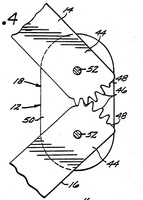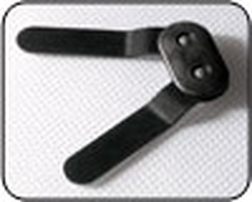Patent US 4 643 176 A1 - Don Joy
It is the joint most used by manufacturers of knee braces. It has a typical shape elongated rectangle with the short sides rounded in a semicircle the center of which, in many joints are recognizable the two pins of rotation without any cover.
With its motion to reverse cycloid, since the early degrees of flexion tends to place back the femoral condyles that after the 45-60 degrees are also included (in an ever more important way) on the rear edges of the tibial plateau.
With its motion to reverse cycloid, since the early degrees of flexion tends to place back the femoral condyles that after the 45-60 degrees are also included (in an ever more important way) on the rear edges of the tibial plateau.


